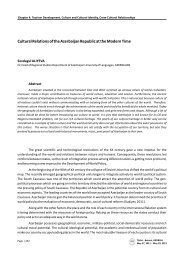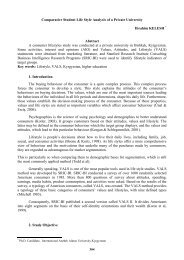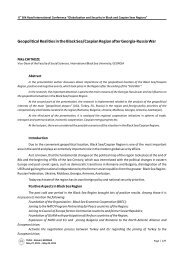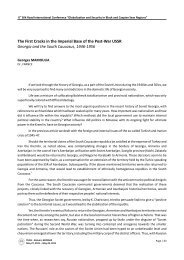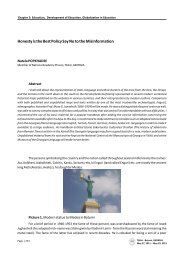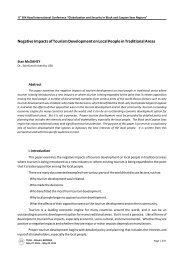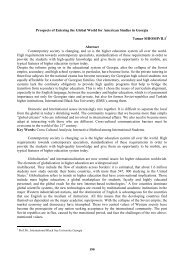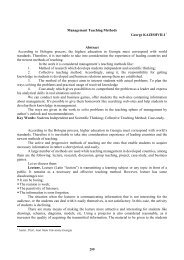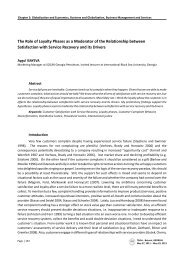Kifayat AGHAYEVA, Intercultural Nonverbal Communication
Kifayat AGHAYEVA, Intercultural Nonverbal Communication
Kifayat AGHAYEVA, Intercultural Nonverbal Communication
You also want an ePaper? Increase the reach of your titles
YUMPU automatically turns print PDFs into web optimized ePapers that Google loves.
th<br />
6 Silk Road International Conference “Globalization and Security in Black and Caspian Seas Regions”<br />
<strong>Intercultural</strong> <strong>Nonverbal</strong> <strong>Communication</strong><br />
<strong>Kifayat</strong> <strong>AGHAYEVA</strong><br />
Associate Professor, Board member, Gender Research Center, AZERBAIJAN<br />
Abstract<br />
There is a popular saying, “actions speak louder than words”. The importance of non-verbal communication in our<br />
global society is especially significant. "<strong>Intercultural</strong> non-verbal communication" refers to the unspoken word between<br />
communicating parties. Two third of communication is transmitted by the non-verbal way. The possibility for<br />
misunderstanding and disagreement regarding non-verbal communication is great because of cultural differences. So,<br />
successful interaction in intercultural situations entails just as much understanding of non-verbal messages as the verbal<br />
ones. Non-verbal communication is one of the key aspects of communication. Its diverse functions include repeating,<br />
accentuating, complementing and contradicting a verbal message. This type of communication also normalizes relations,<br />
such as non-verbal cues conveying when a person should speak or not speak. Finally, non-verbal communication can even<br />
alternate a verbal message through mimics, gestures and facial expressions, particularly when people do not speak the<br />
same language. These features influences intercultural communication and can be responsible for conflict or the increase<br />
of conflict when it leads to bad communication or misinterpretation.<br />
There is a popular saying, “actions speak louder than words”. In reality, it highlights the significance of<br />
non-verbal communication. Non-verbal communication is especially noteworthy in intercultural situations.<br />
Doubtless non-verbal differences account for typical difficulties in communicating.<br />
The importance of non-verbal communication in our global society is especially significant.<br />
"<strong>Intercultural</strong> non-verbal communication" refers to the unspoken word between communicating parties. Twothirds<br />
of communication is transmitted non-verbally. The possibility for misunderstanding and disagreement<br />
regarding non-verbal communication is great because of cultural differences. So, successful interaction in<br />
intercultural situations entails just as much understanding of non-verbal messages as the verbal ones.<br />
Non-verbal communication is one of the key aspects of communication. Its diverse functions include<br />
repeating, accentuating, complementing and contradicting a verbal message. This type of communication also<br />
normalizes relations, such as non-verbal cues conveying when a person should speak or not speak. Finally, nonverbal<br />
communication can even alter a verbal message through mimics, gestures and facial expressions,<br />
particularly when people do not speak the same language.<br />
<strong>Nonverbal</strong> communication is hugely important in any interaction with others because people tend to<br />
look for nonverbal cues when verbal messages are unclear or ambiguous (especially when different languages<br />
are being used) "Since nonverbal behavior arises from our cultural common sense (our ideas about what is<br />
appropriate, normal, and effective as communication in relationships), we use different systems of<br />
understanding gestures, posture, silence, emotional expression, touch, physical appearance, and other<br />
Tbilisi - Batumi, GEORGIA<br />
May 27, 2011 – May 29, 2011<br />
Page | 213
Chapter 4: Tourism Development, Culture and Cultural Identity, Cross-Cultural Relationships<br />
nonverbal cues" (LeBaron, 2003).<br />
<strong>Intercultural</strong> <strong>Communication</strong><br />
Human beings draw close to one another by their common nature but habits and customs keep them<br />
apart (Confucian).<br />
Socrates described two worlds in PHAEDO: the first is a world of imperfection impeded by the inexpert<br />
medium of speech and the better second world of perfection where all things are communicated visually,<br />
without the need for words.<br />
Widespread population migrations have changed the demographics of several nations and new<br />
intercultural identities and communities have been born. The growth of interdependence of people and<br />
cultures in the global society of the twenty-first century has forced us to pay even more attention to<br />
intercultural issues.<br />
All civilizations depend on each-other for different reasons. People of the world carry out<br />
communication through verbal and nonverbal means. The better our intercultural communication skills, the<br />
easier it will be for us to take our place in international society. Typically more interest is focused on verbal<br />
communication than nonverbal communication. Unfortunately, communicating sides make great efforts to<br />
find appropriate vocabulary but neglect nonverbal communication cues. It is important to raise responsiveness<br />
of the nonverbal communication in the process of intercultural communication. My talk deals with some of the<br />
means of nonverbal communication and ways of escaping those cultural disagreements and difficulties. The<br />
main purpose of my study is to examine the role of nonverbal behavior in the context of intercultural<br />
communication.<br />
To overcome such difficulties requires integrating nonverbal communication skills in order to better<br />
communicate interculturally. I'd be very happy if my research plays any role in overcoming these obstacles to<br />
intercultural understanding.<br />
Today the world does not look as huge as in the past. According to Wang, people are coerced to live in<br />
this global world. With the development of globalization, intercultural communication has become more<br />
significant than even before (2007).<br />
Every day, whether we realize it or not, we observe nonverbal communication. We are able to<br />
understand more about the people we come into contact with because of this observation.<br />
The term "intercultural communication" was first used in Edward T. Hall's (1959) book, The Silent<br />
Language, and Hall has been acknowledged to be the founder of the field of intercultural communication.<br />
Throughout the growth of intercultural communication study, Hall's work has remained influential (Rogers et<br />
al. 2002). The Silent Language placed a serious accent on "nonverbal" communication, and a significant<br />
contribution of the book to its readers was its discussion of unseen aspects of human communication, mainly<br />
proxemics (how space affects communication) and chronemics (how time affects communication).<br />
The research of the field of nonverbal communications has grown swiftly over the last few decades,<br />
and it has functions in business, media, international relations, education, and indeed any field which notably<br />
involves interpersonal and group dynamics.<br />
According to Shi-Xu (2001), there are three significant positions that should contain a meaningful<br />
measurement of intercultural communication. First, intercultural communication should be judged at the level<br />
of social acts and not just language interpretation. Accordingly, it is not the accepting of words and sentences<br />
that is so essential, but the social dimension that is worthy of critical notice. Secondly, that intercultural<br />
communication is a socially structured action or message so the meaning of communication cannot be<br />
diminished by words. Thirdly, intercultural communication does not go on in a power vacuum, or equal-power<br />
Page | 214<br />
Tbilisi - Batumi, GEORGIA<br />
May 27, 2011 – May 29, 2011
th<br />
6 Silk Road International Conference “Globalization and Security in Black and Caspian Seas Regions”<br />
dealings. <strong>Intercultural</strong> communication was situated in the context of imbalance of power and inequality in<br />
resources between the east and the west, the north and the south, men and women, the majority and the<br />
minority.<br />
According to Chen and Starosta (1996), the abilities of negotiating cultural meanings and executing<br />
appropriately effective communication behaviors allow people to become competent in intercultural<br />
communication. The correlated challenge is that people from different cultural backgrounds transmit different<br />
understandings and beliefs viewing group dynamics, management techniques, social norms and<br />
communication models.<br />
Political aspects of NVC<br />
In the contemporary international world, great attention and care is taken to bridge cultural<br />
differences among world leaders when they meet. There are whole teams of protocol and pre-event personnel<br />
who go over every detail of an interaction to ensure nothing is missed, mismanaged, or misunderstood.<br />
Cultural differences have significant effects on diplomatic negotiations. Failure to understand and<br />
appreciate these differences can have serious consequences for negotiations. Successful leaders communicate<br />
efficiently—not only with their words, but just as important, through nonverbal actions. Some politicians<br />
understand the effect of body language on the public and may try to use it to their advantage. While some<br />
politicians may be able to influence people with sensitive body language.<br />
Current American history is dominated by presidential politics and also by nonverbals.<br />
Politicians who stare out into the distance during another's speech are subconsciously telling the<br />
audience that he or she doesn't think the person speaking deserves his or her attention. Even a smile can give<br />
away a politician's true feelings.<br />
The most effective leaders are those who transmit charisma and confidence. They connect with others<br />
and stimulate interest. They show emotion. They are labeled "visionaries. <strong>Nonverbal</strong> communication has been<br />
a critical component of American presidential debates from the very first televised forum. In 1960, Richard M.<br />
Nixon's five o'clock shadow helped make him look pale, sickly, and thin. Michael Dukakis was criticized in 1988<br />
for his lack of emotion and stiff posture. George H.W. Bush looked at his watch during a 1992 debate, suggesting<br />
impatience, boredom, or lack of interest. In 2000, Al Gore's sighing and eye-rolling made him less likable.<br />
Clinton's body language is one of the interesting fields for political researchers. So his nonverbal<br />
communication style draws many researchers' attention. I can give some examples.<br />
Both Clinton and his spouse Hillary were masters of nonverbal communication. When accusations<br />
were made in the media, the president and his wife were seen holding hands. When the fires of accusation<br />
were most intense, Mrs. Clinton was seen publicly leaning tightly against her husband's chest. The message was<br />
obvious: "Forget all these allegations; there is nothing wrong here. (Foster, 2000)<br />
Former U.S. President Bill Clinton often bit his lip when trying to appear emotional, such as when he<br />
apologized for the affair with Monica Lewinsky. Did that small gesture win him the public's sympathy (See:<br />
www.bodylanguageexpert.co.uk/body-language-politicians.html)<br />
The gesture dubbed the "Clinton thumb" after one of its most famous users; Bill Clinton is used by<br />
politicians to provide emphasis in speeches. This gesture has the thumb leaning against the thumb-side portion<br />
of the index finger, which is part of a closed fist, or slightly projecting from the fist. An emphatic, it does not<br />
exhibit the anger of the clenched fist or pointing finger, and so is thought to be less threatening. This gesture<br />
was likely adopted by Clinton from John F. Kennedy who can be seen using it in many speeches and images from<br />
his political career (Mankiewicz, 2009).<br />
The current president of the U.S., Barack Obama, also has very interesting nonverbal behavior. One of<br />
Tbilisi - Batumi, GEORGIA<br />
May 27, 2011 – May 29, 2011<br />
Page | 215
Chapter 4: Tourism Development, Culture and Cultural Identity, Cross-Cultural Relationships<br />
the politicians characterizes his body language as following: “Obama is a good speaker, but his stylistic range is<br />
pretty limited. His style lacks the common touch of Roosevelt, Truman, Johnson, Carter, and Clinton. That's a<br />
political problem for him”. However, Obama's success in leadership is sometimes attributed to his use of<br />
appropriate body language. Most notably, his brilliant smile.<br />
Studies show that people prefer more attractive speakers to less attractive. The other facial gestures<br />
that work well for public speakers are three universally understood ones: opening the eyes, raising the<br />
eyebrows, and nodding the head. President Obama, for example, uses each of these gestures, but in particular<br />
he is a great 'nodder'. Watch any speech of his, and you will see him nod at the ends of phrases and sentences.<br />
This has the effect of affirming through body language what his content is saying. It's one reason why we find<br />
him so convincing as a speaker and President (Cost, 2008).<br />
Leaders in general will use different nonverbal behaviors and actions when addressing a crowd or<br />
making a speech than they would in a one-on-one situation. For example, Obama made good use of eye contact<br />
with individuals during his debates with John McCain. He was avoiding eye contact because he has a short<br />
temper and looking at Obama might provoke his anger. America may see his weakness; it was a good strategy<br />
for McCain (see, www.businessweek.com/.../sep2008/ca20080929_440972.htm).<br />
No matter how poised he or she is while giving a speech, certain gestures can give away the true<br />
feelings about something despite what someone's mouth is saying.<br />
The former British Prime Minister Tony Blair also is considered a leader with interesting nonverbal<br />
style. He would fiddle with his little finger when anxious while others note that he may touch his stomach when<br />
under verbal attack. Mr. Blair raises his eyebrows when he wants to appear non-threatening, a submissive<br />
gesture (see, news.bbc.co.uk/2/hi/.../5316916.stm press conference).<br />
Studies show nonverbal communication is the emotional meaning behind what is said. People react<br />
effectively to what they see, or to the tone of voice that is used to speak the words they hear. Everything from<br />
dress, the extent of physical space between the speaker and audience, hand gestures, body movement,<br />
mimics, and tone of voice can make or break a leader's message.<br />
Gender Aspects of NVC<br />
How does our gender affect us in our intercultural interactions Gender has a great influence on all<br />
sides of human communication and raises many profound social matters.<br />
There is communication specialization between men and women, men being more accurate with vocal<br />
and women with visual communication. Research has shown girls display more nurturance communication<br />
behavior than boys and this would account for a higher sensitivity to nonverbal cues (Bullis & Horn, 1995).<br />
Do males and females interact according to different nonverbal agendas <strong>Communication</strong> between<br />
men and women is considered to be cross-cultural communication and women and men are from different<br />
planets. They speak as if they have different dialects and sometimes don't understand each other completely.<br />
What does help you to understand the opposite sex Certainly, a nonverbal communication.<br />
Some gender aspects of nonverbal communication are dependable across cultures. For example,<br />
research has shown that the emotions of enjoyment, anger, fear, sadness, disgust, and surprise are expressed in<br />
similar ways by people around the world. Differences surface with respect to which emotions are acceptable to<br />
display in various cultural settings, and by whom. For instance, it may be more socially acceptable in some<br />
settings in the United States for women to show fear, but not anger, and for men to display anger, but not fear.<br />
In most Westernized countries it is considered normal for two men to shake hands. In some Asian and<br />
Islamic countries it is considered normal for men to kiss each other, either on the cheeks or on the lips. Some<br />
countries also consider men holding hands to be normal. In most westernized countries men kissing or holding<br />
Page | 216<br />
Tbilisi - Batumi, GEORGIA<br />
May 27, 2011 – May 29, 2011
th<br />
6 Silk Road International Conference “Globalization and Security in Black and Caspian Seas Regions”<br />
hands in public would be viewed as homosexual behavior (see, ).<br />
Islamic cultures generally don't approve of any touching between opposite genders (even<br />
handshakes), but consider such touching (including hand holding, hugs) between same-sex to be appropriate.<br />
When traveling to other societies, it is important to understand that there are likely to be significant<br />
gender differences in paralanguage in addition to distinctions in clothes and adornment. In North America, for<br />
instance, men generally prefer face to face conversations and maintain direct eye contact longer. In contrast,<br />
women often converse standing side by side but closer together than is typical of men. Male handshakes tend<br />
to be firmer. North American women usually are more restrained in their use of bold gestures but use more<br />
facial expressions (especially smiles) and are more skilled in interpreting them.<br />
In Japan, women most often speak with an artificially high pitch, especially when conversing with men<br />
in a business or official setting. This is part of the general deference traditionally shown to men. However,<br />
recent research indicates that the pitch of female voices has begun to lower. It has been suggested that this<br />
change is connected with the increased economic and political power of Japanese women.<br />
Studies have been made concerning feminine and masculine pictures of the world, the differences<br />
between feminine and masculine values, and the distinctive features of speech that men and women use.<br />
Women in low-masculinity cultures show more synchrony in their movement than those in high-masculinity<br />
cultures.<br />
It has been suggested women's lower status may negatively influence perceptions of power and<br />
therefore hinder credibility and persuasiveness. Although gender was not investigated in a study by Aguinis,<br />
Simonsen and Pierce (1998), it was found that nervous facial expressions and indirect eye contact hindered<br />
perceptions of power and credibility.<br />
As women's roles in society change and they move to higher positions of power in the work place,<br />
finding the most effective influential measures is needed. But Woods (1996) considers that women's nonverbal<br />
communication ability may be based on interpersonal cognitive complexity rather than status or value placed<br />
on learned nurturance.<br />
According to Becky Michele Mulvaney it is useful to view gender communication as a form of<br />
intercultural communication. First, the author considers that gender is both an influence on and a product of<br />
communication. In short, Becky highlights the primary role played by communication in gender issues.<br />
Second, descriptions of some salient elements of intercultural communication Becky maintains that<br />
gender communication is a form of intercultural communication. Finally, according to the author gender<br />
communication plays an important role in developing effective intercultural communication skills.<br />
NVC across culture<br />
Culture distinctions can influence the means people use to converse non-verbally. As we have already<br />
mentioned above, the verbal language is not as frequently used among diverse populations of the world as<br />
NVC.<br />
When first exposed to a new situation where manners, language and behavior are all strange, people<br />
may experience culture shock with changeable meanings from society to society, and therefore it is easy to see<br />
how misunderstandings may arise. Culture gives meaning to behavior, diverse hand gesticulations, how close<br />
we may stand when communicating, our tolerance and even greetings; consequently, our culture affects every<br />
aspect of NVC. Normally, it is significant to be aware of how smooth relations require persuasiveness with not<br />
only verbal language but visual as well. Very few gesticulations are universally understood across the world.<br />
What is absolutely adequate in one culture may be impolite or even disgusting, in other societies.<br />
Tbilisi - Batumi, GEORGIA<br />
May 27, 2011 – May 29, 2011<br />
Page | 217
Chapter 4: Tourism Development, Culture and Cultural Identity, Cross-Cultural Relationships<br />
We must all learn the art of switching cultural channels to avoid the pain and discomfort of<br />
misinterpretations of non-verbal communication. However, it is indicated in many studies that the failure or<br />
misunderstandings in intercultural communication are largely caused by the misinterpretation or misuse of<br />
nonverbal behaviors (Arasaratnam & Banerjee, 2007).<br />
Studies shows that European Americans generally speak at a distance of 18 to 30 inches, whereas Latin<br />
Americans and Southern Europeans generally communicate at a distance of 8 to 18 inches. The<br />
misunderstanding occurs at an unconscious level that Latinos appear too pushy or overly sexual and that Anglo-<br />
Saxons appear cold, uninterested and prejudiced (see, http://www.beyondintractability.org/essay/crosscultural).<br />
Expressions and gesticulations are not the same around the world. Some gestures, like the “thumbs<br />
up,” which is a positive gesture in the United States, may mean something very different in other cultures. In<br />
Nigeria, the thumbs up gesture is a rude insult! In Australia it is an obscene insult. Another funny example is<br />
spinning your finger around your ear. This is known as the “you're crazy” sign in America and in some other<br />
nations, but in Argentina, it means “you have a phone call!”<br />
Another gesture that can be taken completely differently depending upon where you live is nodding<br />
the head. In most parts of the world, it is a positive or “yes” gesture. In Bulgaria, and parts of Greece and the<br />
Middle East, it means no.<br />
Most people's thinking or feeling is expressed through nonverbal communication. It is the way people<br />
interact with each other without the use of words. In many cases, nonverbal actions can support what a person<br />
is saying while other times, it can be contradictory. It is important to know how to read nonverbal<br />
communication in order to have productive personal and professional relationships with others. Here are some<br />
examples:<br />
Canada<br />
It is polite to maintain good eye contact. Men rise when woman enter the room. It is considered bad<br />
manners to eat while on the street.<br />
No excessive gesturing.<br />
People stand about a half-meter apart when conversing.<br />
Women greet with a firm handshake.<br />
Italy<br />
In churches women should cover their heads; do not wear short sleeves or sleeveless shirts. When<br />
dining only men pour the wine.<br />
Long handshakes<br />
In greetings, warm hugs and kisses are common<br />
Spain<br />
It is popular for men to cross their legs; but is considered unfeminine for women. Eye contact may be<br />
denoting romantic interest.<br />
Men and women always shake.<br />
Both men and women use abroza to greet; Women may accompany that with a cheek kiss.<br />
Iran<br />
Remove shoes when entering home or mosque.<br />
Page | 218<br />
Tbilisi - Batumi, GEORGIA<br />
May 27, 2011 – May 29, 2011
th<br />
6 Silk Road International Conference “Globalization and Security in Black and Caspian Seas Regions”<br />
To signal to someone, put your hand out with your palm down and curl your fingers in scratching<br />
motion.<br />
The thumbs up sign are vulgar.<br />
To signal yes, dip your head down with a slight turn.<br />
To signal no, move your head up and back sharply.<br />
Shaking hands with a child shows respect towards the parents.<br />
Zimbabwe<br />
Applauding denotes appreciation and politeness.<br />
It is rude to maintain eye contact.<br />
Women and girls often curtsey in greetings<br />
Sweden<br />
Eye contact is important when men converse with women, they remove their hat. The male guest of<br />
honor sits on the left of the hostess and the female guest sits to the right of the host. To make a toast, lift your<br />
glass and say, Skoal; the host always makes the first toast. When leaving home, wait to put on your coat after<br />
you have stepped the door.<br />
Firm handshakes.<br />
Men greet woman by tipping their hat.<br />
England<br />
To signal a waiter for the bill, make a motion with both hands of signing your name on paper. Privacy is<br />
very important, do not stare. Tipping at bars is rare.<br />
Loud behavior is considered rude. The victory sign with your palm facing in is considered vulgar.<br />
Never cut in line.<br />
Saudi Arabia<br />
Women are not allowed to drive.<br />
Avoid showing the sole of the shoe; it is considered the lowest dirtiest part of the body. It is not proper<br />
to explore bare shoulders, stomach or legs.<br />
Holding hands or taking someone's elbow is a sign of respect and friendship.<br />
It is disrespectful to cross legs, to place the palm down, fingers spread with your index finger bent down<br />
and pointing outward is to insult someone.<br />
Shaking head from side to side means yes.<br />
By tipping the head backward clicking the tongue, people signal no.<br />
Elders tend to greet by saying, Salaam; men greet with a hug and cheek kiss, veiled women are not<br />
introduced.<br />
It is important that government leaders know about these things. It could be problematic if a president<br />
offended the leader of another nation because of a gesture that was misunderstood.<br />
By recognizing and adjusting for cultural differences that are present across the globe, you can succeed<br />
in business endeavors abroad. (See, 302.tripod.com/soc…/id6.html)<br />
Tbilisi - Batumi, GEORGIA<br />
May 27, 2011 – May 29, 2011<br />
Page | 219
Chapter 4: Tourism Development, Culture and Cultural Identity, Cross-Cultural Relationships<br />
<strong>Nonverbal</strong> communication can send messages as loud and clear as anything said in verbal<br />
communication.<br />
Conclusion<br />
The studies show that inappropriate nonverbal behaviors may cause potential conflicts in intercultural<br />
communication. <strong>Intercultural</strong> communication refers to the communication between people from different<br />
cultures. According to Samovar and Porter (1991) intercultural communication occurs whenever a message is<br />
produced by a member of one culture for consumption by a member of another culture, a message must be<br />
understood. Because of cultural differences in these kinds of contacts, the potential for misunderstanding and<br />
disagreement is great. To reduce this risk, it is important to study intercultural communication.<br />
A culturally-fluent approach to conflict means working over time to understand these and other ways<br />
communication varies across cultures, and applying these understandings in order to enhance relationships<br />
across different cultures.<br />
Cultural communication research tends to focus on understanding communication within one culture<br />
from the insiders' points of view (Gudykunst and Mody 2002). Understanding cross-cultural communication<br />
should be a prerequisite to understanding intercultural communication because cross-cultural communication<br />
looks at how people from differing cultural backgrounds endeavor to communicate. Thus, the core of crosscultural<br />
communication is to establish and understand how people from different cultures communicate with<br />
each other. A new challenge for cultural fluency as a guide to effective intercultural communication is to<br />
generate approaches of investigation on how people from different cultures and speaking different languages<br />
actually influence each other in specific intercultural contexts.<br />
The role of the right strategy of intercultural communication is very important in avoiding<br />
misunderstanding. Globalization demands a greater need for intercultural contact and interdependence.<br />
People of this globalizing world are obliged to redesign intercultural communication to achieve effectual<br />
intercultural communication proficiency.<br />
Books<br />
Reference<br />
Arasaratnam, L. A., & Banerjee, S. C. Ethnocentrism and Sensation Seeking as Variables that Influence <strong>Intercultural</strong><br />
Contact-Seeking Behaviour: A Path Analysis. <strong>Communication</strong> Research Reports, 2007, 24(4), 303-310.<br />
Bullis, C., & Horn, C. Get a little closer: Further examination of nonverbal comforting strategies. <strong>Communication</strong><br />
Reports, 1995, 8 (1), 10-17.<br />
Gudykunst, W. B., and Mody, B. Handbook of international and intercultural communication (2nd Ed.). Thousand Oaks,<br />
CA: Sage, 2002.<br />
Hall, E. T. The Silent Language. New York: Doubleday, 1959.<br />
Knapp, M.L., & Hall, J. A. <strong>Nonverbal</strong> communication in human interaction (5th Ed.). New York: Harcourt Brace<br />
Jovanovich, 2002.<br />
K. Neill Foster, <strong>Nonverbal</strong> <strong>Communication</strong> and Spiritual Discernment, Alliance Academic Review, 2000<br />
LeBaron, M. (2003 July). Cross-cultural communication. Beyond Intractability. Eds. G. Burgess & H. Burgess. Conflict<br />
Research Consortium, University of Colorado, Boulder. Retrieved August 1, 2006, from<br />
http://www.beyondintractability.org/essay/cross-cultural_communication.<br />
Mankiewicz, Josh "For politicians, the gesture's the thing: 'The Clinton Thumb' has become a bipartisan weapon in<br />
Washington." MSNBC.com Retrieved 17-06-2009.<br />
Rogers, E. M., Hart, W. B., & Miike, Y. Edward T. Hall and the history of intercultural communication: The United States<br />
and Japan. Keio <strong>Communication</strong> Review, 2002, 24, pp. 3-26.<br />
Larry A. Samovar and Richard E. Porter: Basic Principles of <strong>Intercultural</strong> <strong>Communication</strong>. In Larry A. Samovar and<br />
Page | 220<br />
Tbilisi - Batumi, GEORGIA<br />
May 27, 2011 – May 29, 2011
th<br />
6 Silk Road International Conference “Globalization and Security in Black and Caspian Seas Regions”<br />
Richard E. Porter: <strong>Intercultural</strong> <strong>Communication</strong>: A Reader. Wadsworth, Inc., CA: USA, 1991.<br />
Shi-Xu. Critical pedagogy and intercultural and intercultural communication: creating discourses of diversity, equality,<br />
common goals and rational-moral motivation, 2001.<br />
Wang, Y. <strong>Intercultural</strong> awareness: theory into research. Paper presented at the AARE 2006, International Education<br />
Research Conference, 2007.<br />
Woods, E. Associations of nonverbal decoding ability with indices of person-centered communicative ability.<br />
<strong>Communication</strong> Reports, 1996, 9 (1), 13-22.<br />
Journals<br />
Aguinis, H., Simonsen, M. M., & Pierce, C. A. Effects of nonverbal behavior on perceptions of power bases. The Journal<br />
of Social Psychology, 1998, 138 (4), 445-469.<br />
Chen, G. M., & Starosta, W. <strong>Intercultural</strong> communication competence: A synthesis. In S. Deetz (Ed.), <strong>Communication</strong><br />
Yearbook (Vol. 19, pp. 353-383). Thousand Oaks, CA: Sage, 1996.<br />
Charlene Wu, Journal of Visual Literacy, <strong>Nonverbal</strong> <strong>Communication</strong> Web Project. 302. tripod.com/soc…/id6.html<br />
Electronic Version]. Journal of <strong>Intercultural</strong> studies, 22(3), 281-290.<br />
Online reference<br />
Gender Differences in <strong>Communication</strong>: An <strong>Intercultural</strong> Experience by Becky Michele Mulvaney, 2005,<br />
feminism.eserver.org/gender/.../gender-differences.txt<br />
www.bodylanguageexpert.co.uk/body-language-politicians.html<br />
Speakers. publicwords.typepad.com/.../the-secrets-of-president-obamas-communication -success-4.html -<br />
Gender Differences in <strong>Communication</strong>: An <strong>Intercultural</strong> Experience by Becky Michele Mulvaney, 2005,<br />
feminism.eserver.org/gender/.../gender-differences.txt).<br />
"Body Language." Wikipedia, the free encyclopedia. 18 December 2004, http://en.wikipedia.org/wiki/Body Language).<br />
news.bbc.co.uk/2/hi/.../5316916.stm press conference<br />
www.businessweek.com/…/sep2008/ca20080929_440972.htm).<br />
Film<br />
Dane Archer, Gender and <strong>Communication</strong>: Male-Female Differences in Language and <strong>Nonverbal</strong> Behavior, 42 min.<br />
Color. 2001.<br />
Tbilisi - Batumi, GEORGIA<br />
May 27, 2011 – May 29, 2011<br />
Page | 221



